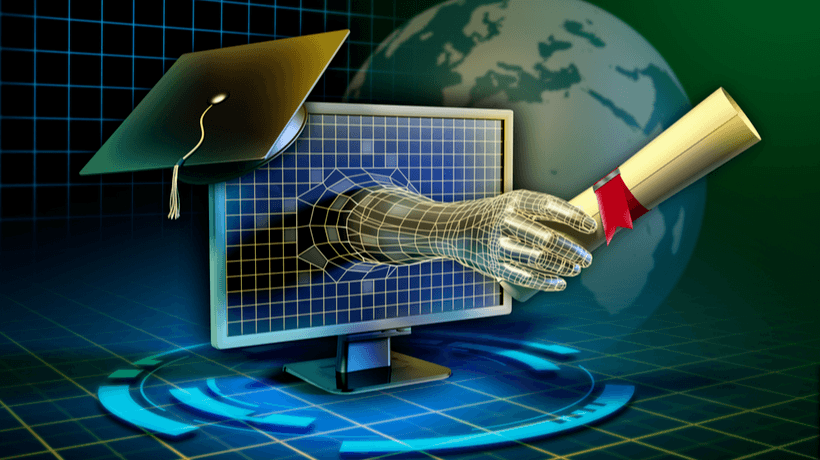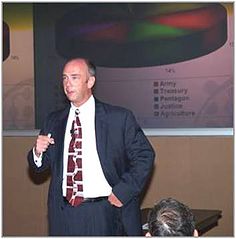Cognitive Computing In Education And The IBM Watson Application
LearningLovers.org was invited to IBM headquarters in Madrid, where we had the chance to expand on using Watson applications and cognitive computing in education, training, and knowledge management. This is the result:
How Does Watson Arise
"The origin of all this is part of a TV program that emerges in the US and that is called Jeopardy! For the first time, the winners of the contest were faced with a machine that understood natural language and was able to answer complex questions... IBM, after the positive result of this experience, saw that it was a very good way to export this technology to other environments, such as business.

Since then, a special division of cognitive issues, with which all members of the organization have to work, with an investment of one billion dollars from IBM, was created. Recently, another center in Munich also opened. It is one of the priorities of the company.
Basically, it is based on cognitive intelligence technology, i.e. trying to create a cybernetic system, which somehow emulates the way human beings learn. Humans usually access to knowledge through a series of actions such as storing, retrieving, understanding, using, and organizing the information acquired by the senses.
From that standpoint, Watson resembles that kind of behavior. It is able to learn that way and also employ afterwards other techniques used by humans, as is learn by experience. That is roughly what the cognitive computing is all about."
Watson Functionalities
"Watson gives us 2 very immediate functionalities:
- The advisor.
- The discoverer: It helps to discover relations between the vast amounts of information it has access to, in a very short period of time.
These are 2 super strong points. It would be almost impossible for a human to address or draw conclusions with a solid base among the welter of data; it would overwhelms us. It is unfeasible for the human being.
Especially, cognitive abilities allow the system to understand the person as if it were another person, i.e., it allows to understand what it is being asked and what is being talked about. It also offers the ability to assimilate a vast amount of information in times that a human cannot, and it looks for relationships between them.
In the end, we are emulating people. It is said that we differ from other animals that also think, due to our ability to relate concepts. There are animals that are very intelligent too. We have the experience and ability to relate different concepts and draw a conclusion. In the end, Watson is doing something similar: With different sources of data grafted into its body of information, it is able to understand that there is a document related to another one because both are talking about a similar concept. So, for example, it relates a concept of medicine with a mathematical concept. It is able to give you an answer based on different evidence."
Watson In Education
"In the area of education the spectrum is so broad, that from anything that has to do with data you can extract some juice, turning it into information, and, from there, develop or improve new models. Basically, broadly, in education it is included anything related to college, higher education, or high end, where there are several lines of work:
- The administration itself.
The institution can benefit from all capabilities of Watson, as it can analyze their data and offer a 360 vision of their students. - Research.
To guide it from the cognitive point of view, and then to offer that research capability to different industries. - Research dedicated to students.
We can make life easier for students within their educational environment. For example, a student coming from an international exchange can access via their mobile and interact in their native language on legal issues about their visa, campus information, legal information that may affect them, etc.
In the end, we customize each Watson as our own. This gives an added value, as no Watson between organizations or companies is equal, as each enterprise teaches their own following their interest. Ii is the same thing with education: The scope is very broad, with cases like students who seek counselors/"career advisors" based on the studies they are taking; or international student assistants; or even the wizard to student life in the city they are, to inform them about all kind of activities."
A Child Education Project
https://www.youtube.com/watch?v=kl6A5E5oHb4
Mariano has informed us about the collaboration between IBM and Sesame Workshop to use Watson cognitive computing technology in order to help preschool education advance worldwide.
Together, they will develop a new category of educational platforms and products designed to suit the learning preferences and fitness levels of preschoolers.
Research shows that, to a large extent, brain development occurs in the first 5 years of life, turning these years critical for the development of a child's learning. With the Sesame Workshop educational material and Watson's ability to learn, understand patterns, and adapt content, interactive interfaces and platforms developed by both institutions could someday help to strengthen early reading, identify, and recommend early intervention where necessary, as well as to create a highly personalized learning, complementing the roles that parents and teachers play in learning in early childhood.
The goal is to bring adaptive learning to the next level; the creation of educational platforms that leverage cognitive computing to advance fundamentally in ways young children learn. IBM and Sesame Workshop arise developing possible tools, such as:
- A reading application.
To learn to read through an application that reads with the child, creating interactive game experiences and using their own words. For example, the boy is told "Let's play ball with the dog". Watson then analyzes the child's response in real time and it dynamically adapts to his or her interests based on content, so that reading is more fun by completing stories with characters, animals, places, and toys that the child likes. - A very intelligent toy.
It could be a stuffed personalized Elmo, who can listen and respond, using the child's information to create recreational activities. With Watson cognitive computing capabilities embedded in Elmo, the toy is adapted to the abilities of a child's development over time (for example, to practice the alphabet or counting up to 20). Once these skills are mastered, Elmo can provide new activities for further learning. - Classroom tools.
An application that meets recent findings of science learning to help teachers design learning experiences tailored to individual needs of each student could be developed. Watson focuses on learning objectives that are most relevant to a specific teacher and to the child at the time. The tool can also proactively identify concepts that some students may need, and it suggests different learning experiences and accelerated learning strategies.
Cognitive Cloud Computing
Mariano tells us: "Cognitive computing is a computer with a huge potential; there have always been very advanced technologies. What is new now is that, thanks to the cloud, this powerful technology is available to anyone. Through Bluemix a popularization occurs, and it adapts to suit each project.
We are in several initiatives, including with the Government of Lanzarote, where we have this technology, and they are interested in doing a cognitive application to help assist visitors. They have a contest to invite developers with solutions that help them with that situation.
What the whole set of cognitive modules available in the cloud does, is that access to applications becomes very fast. I, specifically, have contact with many partners (one has already been in Lanzarote) who are developing many applications; not only applications, but even with our cognitive APIs they are creating new APIs that provide functionality for a company, person, or entity to develop their application. They just have to directly connect to develop their applications."
Training Within The Company
"A quite important financial client in Spain has told me: 'I will use Watson for my people (they have more than 5000 employees) to find the training they need without having to start searching in a course catalog, because sometimes there are MOOCs, or apps, or PDFs. What I want is this to be dynamic and get easily updated.' If a person requests 'I need to know software for foreign trade with China and Denmark', for example, then that specific training module about that subject will be shown.
As for training within the company itself, it has enough applications today. Watson is an 'accompaniment' that enhances the capabilities of a person. It helps you take better decisions with more accurate information on a particular point.
Watson is very good at answering questions, understanding the question and answering it with evidence, but it does not take a coach function in the sense that it doesn't help the individual draw from themselves their own potential. Watson knows a lot; what it does is give you the evidence-based response. It shows the reasoning which led it to the answer. This is what differentiates it from Google.
The other day, I read an article in the newspaper of a researcher. I liked the example he used: In the crossword, the important thing is not knowing the answer, but to understand the questions that are being asked. The important thing is that Watson is able to understand a very complex issue. The answers are there and can be taken, but coming to understand what answers have to be chosen is the important point. In fact, a sample is Jeopardy! in this sense: In the end, it gives you the track so you can get to an answer, which is what crosswords do. It is much more complex in that sense, because you have to master, have a vision of far greater knowledge; Watson also gives you what the reasoning is, until saying 'This is what takes me to a more confident level'."
Personalized Learning
"I think one of the most important capabilities of Watson is customizability. There are not two customers with an equal Watson. It's not a bag of knowledge to which everyone has access. You can teach the system what you need. For example, you can have a Watson who knows much about medicine but knows nothing about golf. It gives you the ability to customize that data set to your real needs.
There, also enterprise-level skills are taking part. There will be companies that want Watson to be useful for certain kinds of things, and they do not want its knowledge, this teaching that they have given to Watson, to be shared with a competitor."
Watson And Social Working
"An investment has been made to bring Watson to Africa from a social point of view. Watson may not be very important to teach children in Africa; this is not the primary mission. But perhaps it is getting to know why adolescents in Africa cannot read, write, or do math. Watson, through the data, can identify that in some regions there is contaminated water, outbreaks of cholera by the contaminated water and no basic assistance, for example, or that due to their customs in these populations, the older brothers must remain in the care of the rest of the family, the elderly, and the other children. Establishing this relationship between data, that apparently is independent and that humans are unable to connect so quickly, gives us the chance to come to a conclusion in real time and apply some kind of solution to the cause of the problem, because you know that the child will not go to school and you have to fix this.
This is an anthropological and social dimension. It is the most important part that is being given in such computations. Offering this approach is necessary. The same thing happens in the smart cities, for example. We know that we can have it all sensorized, but imagine if with such data we enter another dimension, which is what we are talking about: An anthropological, sociological dimension. At best, the sensors will tell us that garbage cans are badly closed because they are broken, as there is young population where there are no centers or leisure activity. This relationship data can influence where we need to improve."
How Does Watson Work
"Watson works with what are called corpus or bodies of information. A Watson instance or module works with its own body of information. This body of information is the one that goes to internet to look for things:
- Intake of information.
This is a previous process which can be with structured and unstructured information. - Workout.
This is a second phase; you may link it to reliable sources. For example, you can define that medical regulation is reliable in a given source. You can also upload data; the training team (monthly, weekly, or daily) also makes an update. Thus, there are may be two ways of working:- One in which Watson automatically learns, which would be for example a solution of Watson at a university, where Watson is learning.
- Or maybe they say 'We just don't want Watson to learn from everyone who touches it, because we don't know if we can trust the person that is giving feedback on this response, his knowledge'. What we do then is: 'Watson gives me an answer, but it is an inappropriate response, which I did not like, and then I mark it, and that goes to a log that comes to the coaches, and they decide whether I am right or not, and whether Watson have to train with this question or not.'
- These are the 3 ways to learn, which are: The intake of information, the coaching staff and learning from what it does when interacting with people.
Data is in all forms and variables we know: Photos, video, audio, etc. Whatever it is a digital piece. It is a solution that is in the cloud; it is not installable. There are some APIs and you can cognitive them as much as you want. It is an open standard and it is fully transparent to end users. It would not be possible this was not at a cloud level, because in the end, what really matters is the ability to give the super fast response. The ability you get in the cloud, the scalability, the flexibility, are only possible in this regard: You have adequate computing capacity to the case you're dealing with. You have no need to make an oversized investment to have it in your own servers. Obviously, there is an initial investment for the project development or application or whatever it takes, but then the payment is a payment for use. When you are running the API, you pay."
Watson And The Internet Of Things (IoT)
"Another line is Watson IoT, where there are several demos available online. You can check, for example, the emotional state of a written text: If a mail content is very tough or aggressive or humorous. Then there is another one for image recognition, where you can use photographs or your own system, and also for the recognition of people (which identifies the gender, age, if it's a celebrity it tells you who he or she is) by the training that has been done before. There is another one for text to speech and for speech to text...
Then, there is also the Watson Search, an application developed by Bon Appetit magazine, and combines ingredients to invent innovative recipes, mixing ingredients such as a cauliflower with an avocado. It is looking for chemical similarities to the component level, at the molecular level, and it tells you the level of affinity.
For blind people, if you have a person with appropriate glasses, it recognizes objects in front of them, and it is a kind of virtual reality, as it becomes sound, so that the blind person gets to hear a different sound with each object. Depending on where you move your head, if the object you have in front is cylindrical, or cubic, Watson detects its shape and through speakers that are installed in your ear, it emits a particular sound for each shape. If connected to a mobile via bluetooth, Watson has the ability to recognize what the object is (a bottle, for example), or who you are, when you train it for it, or if the person in front of it is a man or a woman, how old he/she is, etc.
Speech recognition is one of the most difficult situations in technology, because image recognition or text recognition reaches the human level (it fails as much as a human does). The issue of voice recognition is more complex due to the accents, or how we “sing” things... You walk into another dimension. But the level of sophistication is already very high. It does not reach the level of humans, but there it is. Then, it also depends on the language. For example, in English language, it almost reaches the human level. In Spanish language, it still lacks a bit of travel, but it is going at an incredible speed."
Watson And Augmented Reality
"There are projects of augmented reality, especially in the manufacturing environment. The power is having some augmented reality glasses, and these glasses have somehow that cognitive intelligence to tell the operator what screws they have to press, in what order they have to do a process... in the end, it comes to help, because the human being is fatigued or does not have their best day, and if you are doing some kind of delicate operation, having help, a counselor who is saying 'First tighten the screw A, once it is closed, you go to B...', somehow that helps better perform tasks.
In education, in counselors for students, it is able to see the skill level or 'skilling' that is being asked in the job market, and guide them on the courses they need to do to fit in the job post. Or, it indicates the probability of finding a job with the set of skills that has been acquired.
It even can help educational institutions decide what their educational offerings have to be, so they can define their brochure much faster than the ones that don't use cognitive education systems. You have to capture the profiles suiting the industry and then compare them with the course catalog you have. Conversely, from the university's point of view, facing the company, you can also explain that your students have refocused the 'skills' needed for that kind of market."
Watson And Project-Based Learning (PBL)
"In PBL, Watson can function as a student advisor. It's like a call center. First, they will come to Watson for the information, and if they do not get it there, then they will go to the teacher."
Watson's Future
"About the future, as Einstein said, all we can say is that it will change. Here there is technology and there are ideas, but in the end, everything depends on the imagination that people have. I get surprised by some startups and so many spin offs emerging from universities, because completely disruptive young people come and you give them cloud technology they can access, use it, and do everything much faster."








